Literature Review: Exploring Adolescent Depression Causes and Effects
VerifiedAdded on 2020/05/28
|6
|1258
|48
Literature Review
AI Summary
This literature review synthesizes research on adolescent depression, examining various contributing factors and potential treatments. It analyzes five articles focusing on the interplay of genetic and environmental influences, including the impact of gene-environment interactions and parental r...
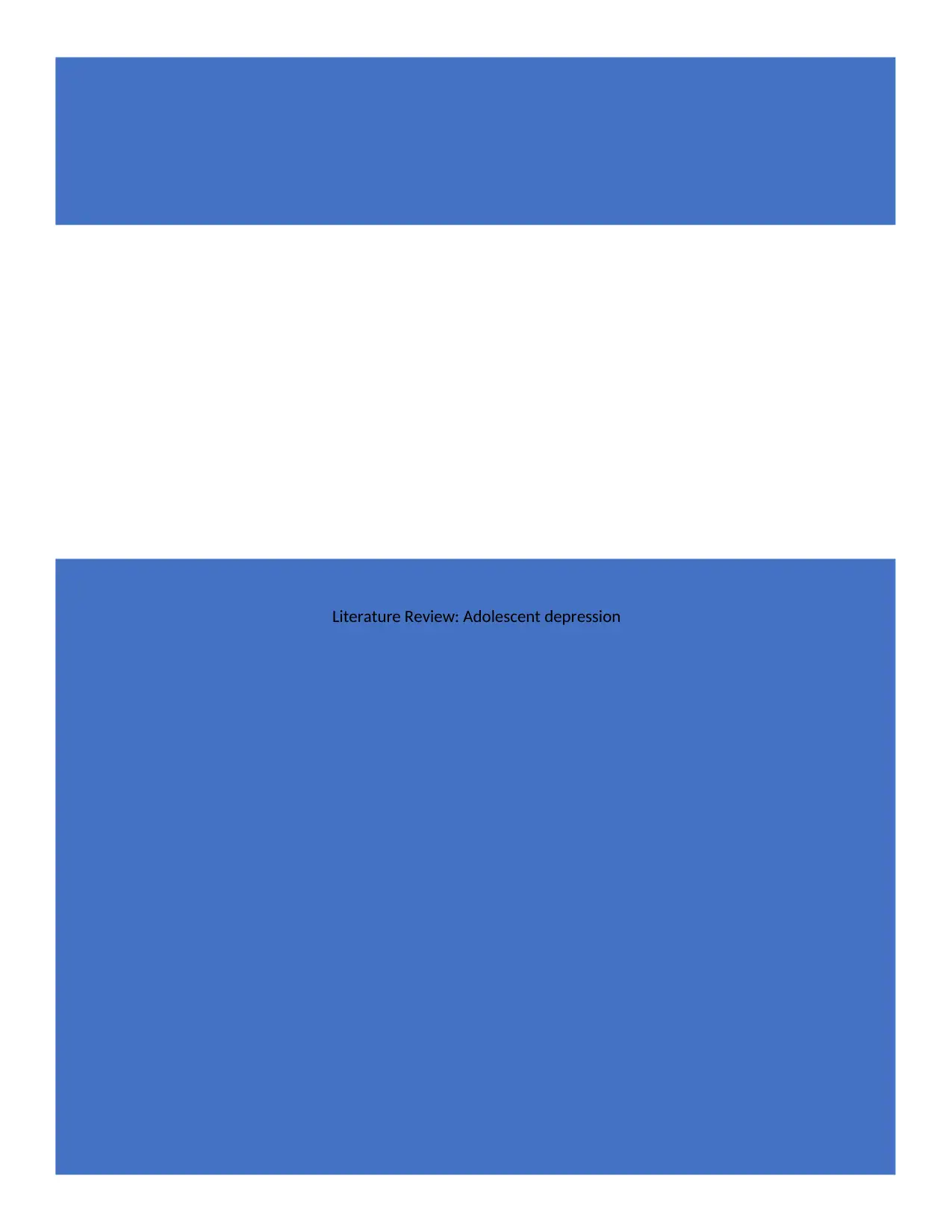
Literature Review: Adolescent depression
Paraphrase This Document
Need a fresh take? Get an instant paraphrase of this document with our AI Paraphraser
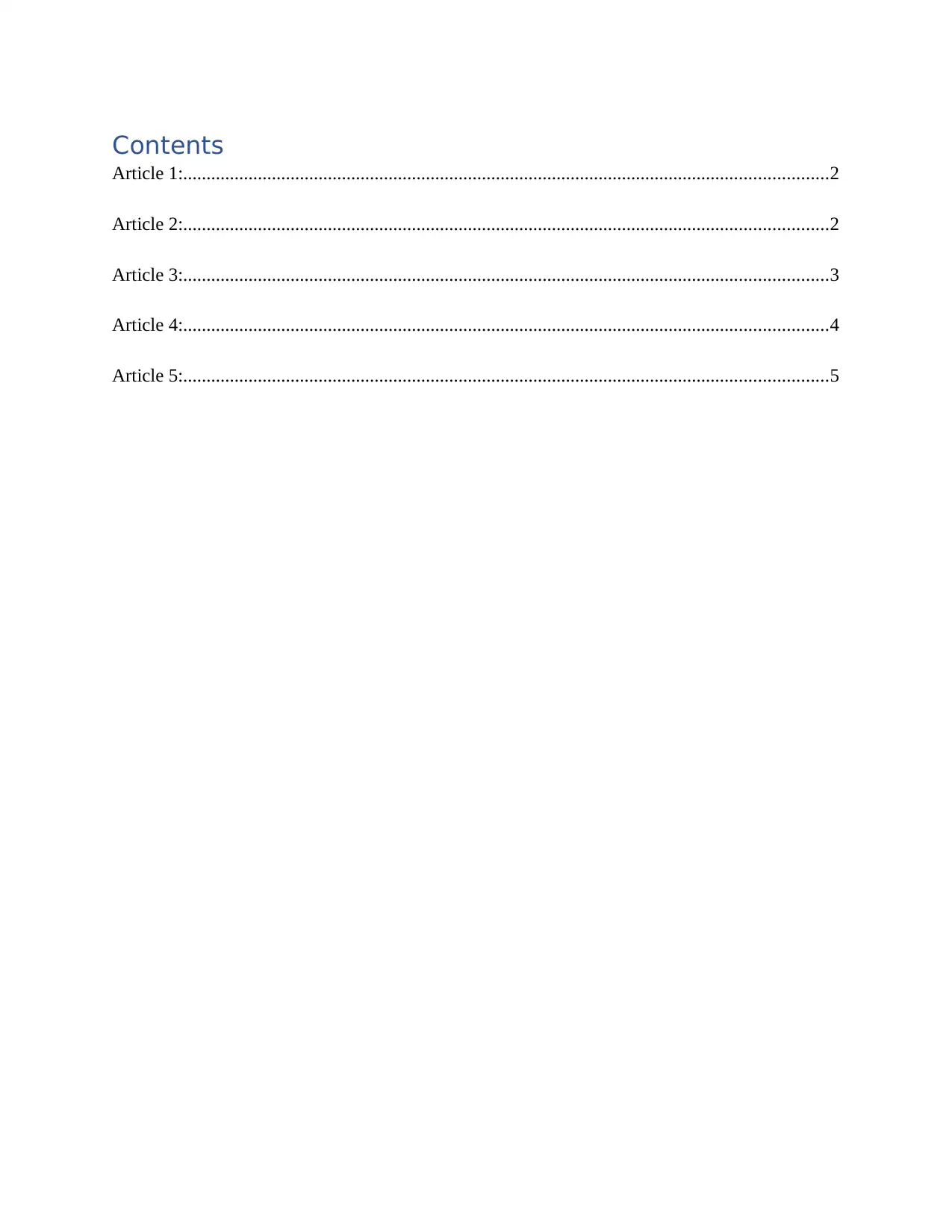
Contents
Article 1:..........................................................................................................................................2
Article 2:..........................................................................................................................................2
Article 3:..........................................................................................................................................3
Article 4:..........................................................................................................................................4
Article 5:..........................................................................................................................................5
Article 1:..........................................................................................................................................2
Article 2:..........................................................................................................................................2
Article 3:..........................................................................................................................................3
Article 4:..........................................................................................................................................4
Article 5:..........................................................................................................................................5
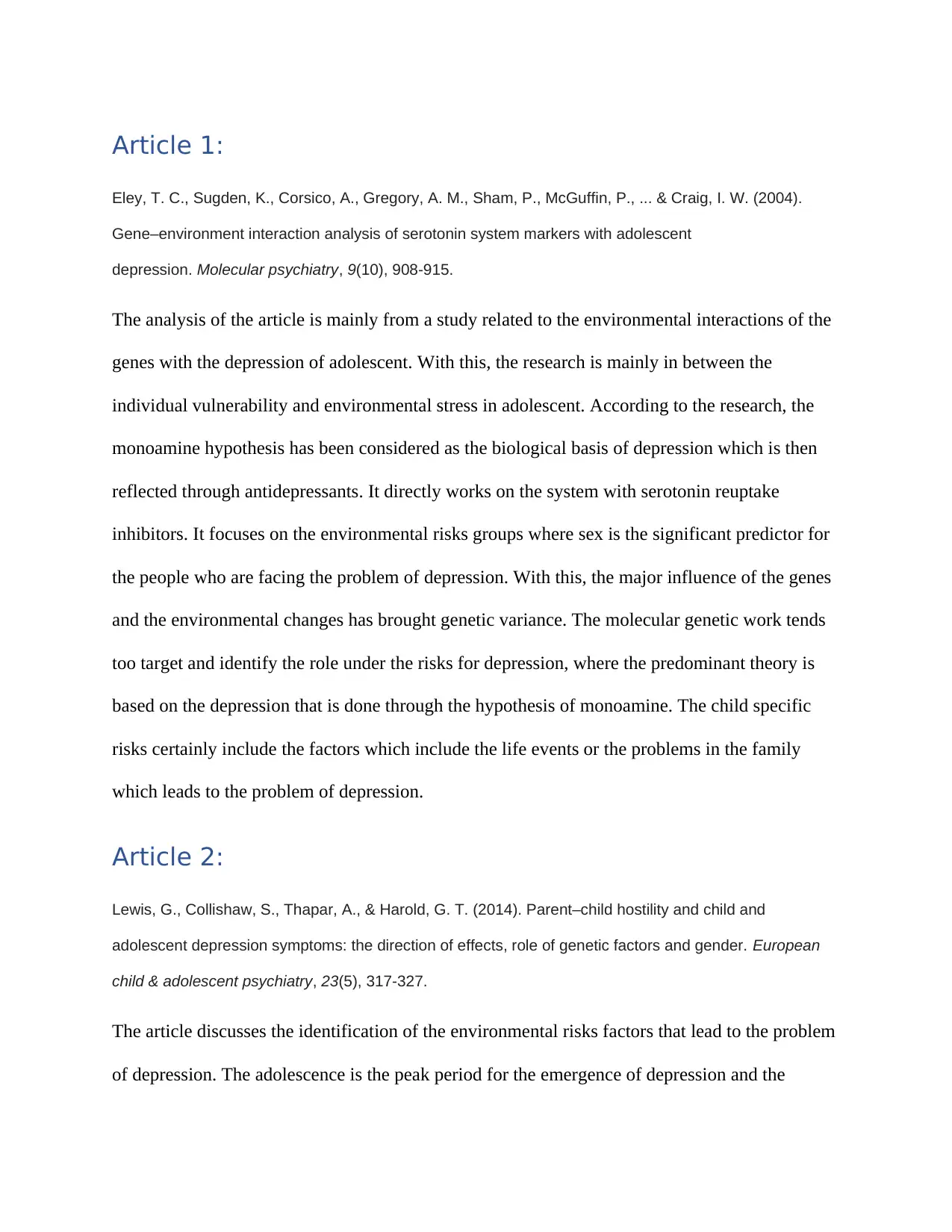
Article 1:
Eley, T. C., Sugden, K., Corsico, A., Gregory, A. M., Sham, P., McGuffin, P., ... & Craig, I. W. (2004).
Gene–environment interaction analysis of serotonin system markers with adolescent
depression. Molecular psychiatry, 9(10), 908-915.
The analysis of the article is mainly from a study related to the environmental interactions of the
genes with the depression of adolescent. With this, the research is mainly in between the
individual vulnerability and environmental stress in adolescent. According to the research, the
monoamine hypothesis has been considered as the biological basis of depression which is then
reflected through antidepressants. It directly works on the system with serotonin reuptake
inhibitors. It focuses on the environmental risks groups where sex is the significant predictor for
the people who are facing the problem of depression. With this, the major influence of the genes
and the environmental changes has brought genetic variance. The molecular genetic work tends
too target and identify the role under the risks for depression, where the predominant theory is
based on the depression that is done through the hypothesis of monoamine. The child specific
risks certainly include the factors which include the life events or the problems in the family
which leads to the problem of depression.
Article 2:
Lewis, G., Collishaw, S., Thapar, A., & Harold, G. T. (2014). Parent–child hostility and child and
adolescent depression symptoms: the direction of effects, role of genetic factors and gender. European
child & adolescent psychiatry, 23(5), 317-327.
The article discusses the identification of the environmental risks factors that lead to the problem
of depression. The adolescence is the peak period for the emergence of depression and the
Eley, T. C., Sugden, K., Corsico, A., Gregory, A. M., Sham, P., McGuffin, P., ... & Craig, I. W. (2004).
Gene–environment interaction analysis of serotonin system markers with adolescent
depression. Molecular psychiatry, 9(10), 908-915.
The analysis of the article is mainly from a study related to the environmental interactions of the
genes with the depression of adolescent. With this, the research is mainly in between the
individual vulnerability and environmental stress in adolescent. According to the research, the
monoamine hypothesis has been considered as the biological basis of depression which is then
reflected through antidepressants. It directly works on the system with serotonin reuptake
inhibitors. It focuses on the environmental risks groups where sex is the significant predictor for
the people who are facing the problem of depression. With this, the major influence of the genes
and the environmental changes has brought genetic variance. The molecular genetic work tends
too target and identify the role under the risks for depression, where the predominant theory is
based on the depression that is done through the hypothesis of monoamine. The child specific
risks certainly include the factors which include the life events or the problems in the family
which leads to the problem of depression.
Article 2:
Lewis, G., Collishaw, S., Thapar, A., & Harold, G. T. (2014). Parent–child hostility and child and
adolescent depression symptoms: the direction of effects, role of genetic factors and gender. European
child & adolescent psychiatry, 23(5), 317-327.
The article discusses the identification of the environmental risks factors that lead to the problem
of depression. The adolescence is the peak period for the emergence of depression and the
You're viewing a preview
Unlock full access by subscribing today!
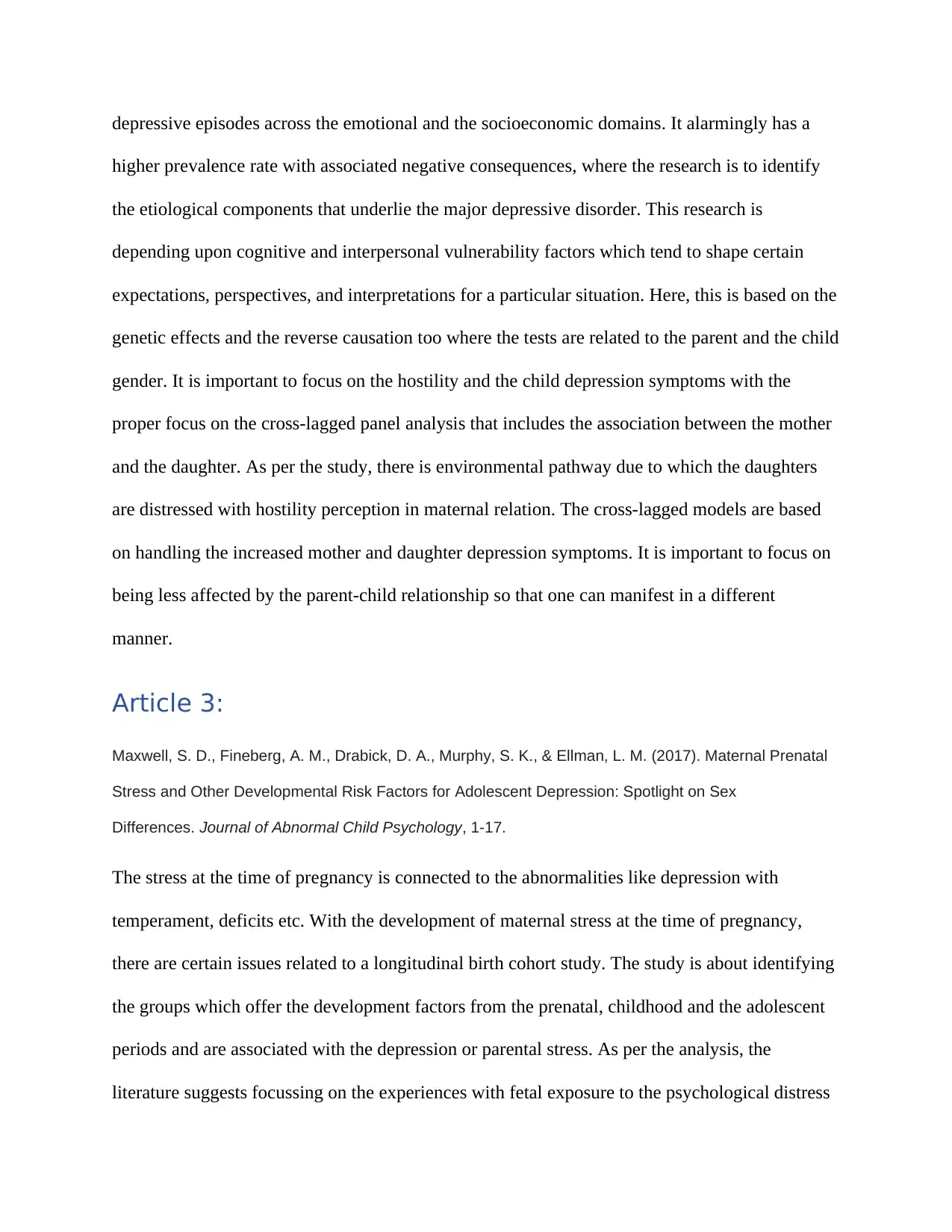
depressive episodes across the emotional and the socioeconomic domains. It alarmingly has a
higher prevalence rate with associated negative consequences, where the research is to identify
the etiological components that underlie the major depressive disorder. This research is
depending upon cognitive and interpersonal vulnerability factors which tend to shape certain
expectations, perspectives, and interpretations for a particular situation. Here, this is based on the
genetic effects and the reverse causation too where the tests are related to the parent and the child
gender. It is important to focus on the hostility and the child depression symptoms with the
proper focus on the cross-lagged panel analysis that includes the association between the mother
and the daughter. As per the study, there is environmental pathway due to which the daughters
are distressed with hostility perception in maternal relation. The cross-lagged models are based
on handling the increased mother and daughter depression symptoms. It is important to focus on
being less affected by the parent-child relationship so that one can manifest in a different
manner.
Article 3:
Maxwell, S. D., Fineberg, A. M., Drabick, D. A., Murphy, S. K., & Ellman, L. M. (2017). Maternal Prenatal
Stress and Other Developmental Risk Factors for Adolescent Depression: Spotlight on Sex
Differences. Journal of Abnormal Child Psychology, 1-17.
The stress at the time of pregnancy is connected to the abnormalities like depression with
temperament, deficits etc. With the development of maternal stress at the time of pregnancy,
there are certain issues related to a longitudinal birth cohort study. The study is about identifying
the groups which offer the development factors from the prenatal, childhood and the adolescent
periods and are associated with the depression or parental stress. As per the analysis, the
literature suggests focussing on the experiences with fetal exposure to the psychological distress
higher prevalence rate with associated negative consequences, where the research is to identify
the etiological components that underlie the major depressive disorder. This research is
depending upon cognitive and interpersonal vulnerability factors which tend to shape certain
expectations, perspectives, and interpretations for a particular situation. Here, this is based on the
genetic effects and the reverse causation too where the tests are related to the parent and the child
gender. It is important to focus on the hostility and the child depression symptoms with the
proper focus on the cross-lagged panel analysis that includes the association between the mother
and the daughter. As per the study, there is environmental pathway due to which the daughters
are distressed with hostility perception in maternal relation. The cross-lagged models are based
on handling the increased mother and daughter depression symptoms. It is important to focus on
being less affected by the parent-child relationship so that one can manifest in a different
manner.
Article 3:
Maxwell, S. D., Fineberg, A. M., Drabick, D. A., Murphy, S. K., & Ellman, L. M. (2017). Maternal Prenatal
Stress and Other Developmental Risk Factors for Adolescent Depression: Spotlight on Sex
Differences. Journal of Abnormal Child Psychology, 1-17.
The stress at the time of pregnancy is connected to the abnormalities like depression with
temperament, deficits etc. With the development of maternal stress at the time of pregnancy,
there are certain issues related to a longitudinal birth cohort study. The study is about identifying
the groups which offer the development factors from the prenatal, childhood and the adolescent
periods and are associated with the depression or parental stress. As per the analysis, the
literature suggests focussing on the experiences with fetal exposure to the psychological distress
Paraphrase This Document
Need a fresh take? Get an instant paraphrase of this document with our AI Paraphraser
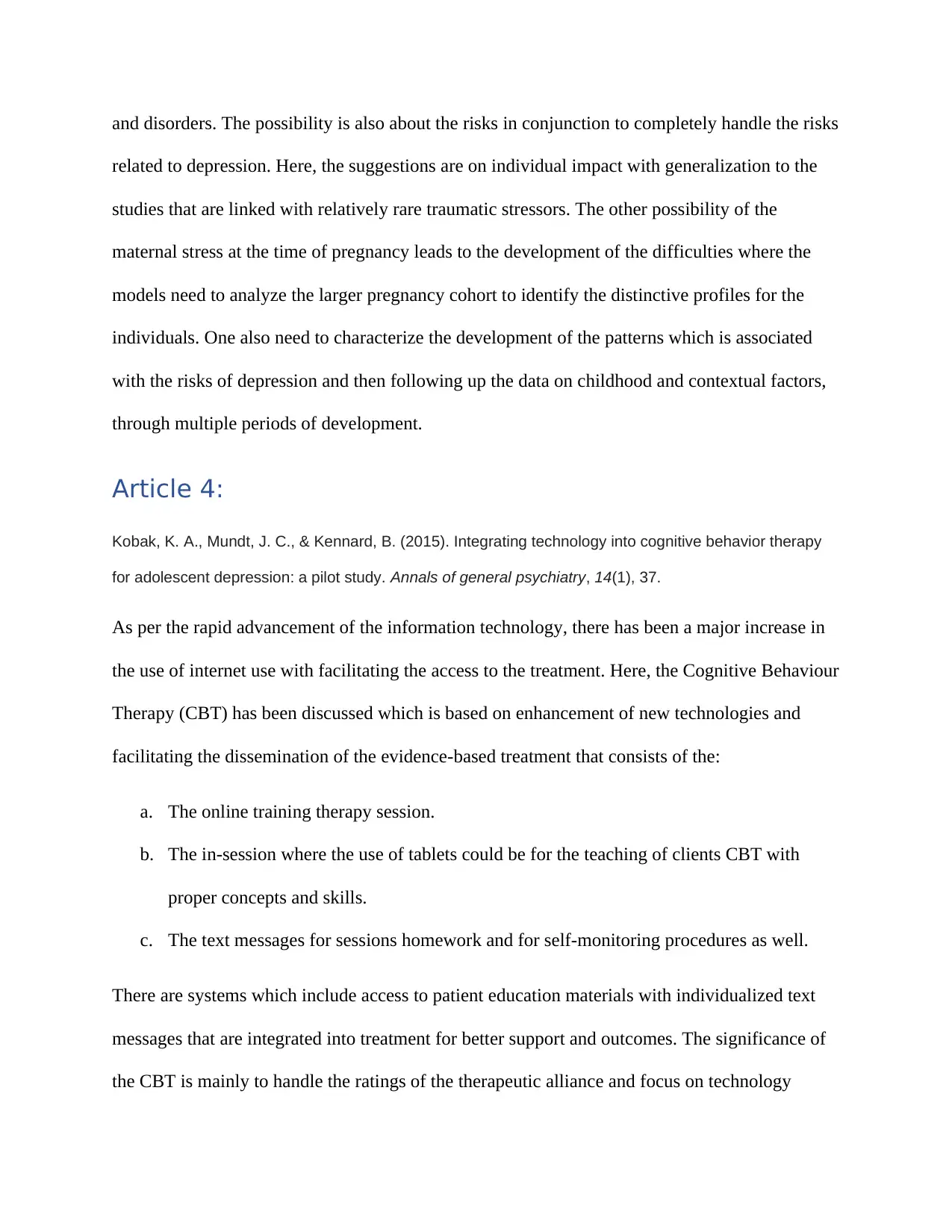
and disorders. The possibility is also about the risks in conjunction to completely handle the risks
related to depression. Here, the suggestions are on individual impact with generalization to the
studies that are linked with relatively rare traumatic stressors. The other possibility of the
maternal stress at the time of pregnancy leads to the development of the difficulties where the
models need to analyze the larger pregnancy cohort to identify the distinctive profiles for the
individuals. One also need to characterize the development of the patterns which is associated
with the risks of depression and then following up the data on childhood and contextual factors,
through multiple periods of development.
Article 4:
Kobak, K. A., Mundt, J. C., & Kennard, B. (2015). Integrating technology into cognitive behavior therapy
for adolescent depression: a pilot study. Annals of general psychiatry, 14(1), 37.
As per the rapid advancement of the information technology, there has been a major increase in
the use of internet use with facilitating the access to the treatment. Here, the Cognitive Behaviour
Therapy (CBT) has been discussed which is based on enhancement of new technologies and
facilitating the dissemination of the evidence-based treatment that consists of the:
a. The online training therapy session.
b. The in-session where the use of tablets could be for the teaching of clients CBT with
proper concepts and skills.
c. The text messages for sessions homework and for self-monitoring procedures as well.
There are systems which include access to patient education materials with individualized text
messages that are integrated into treatment for better support and outcomes. The significance of
the CBT is mainly to handle the ratings of the therapeutic alliance and focus on technology
related to depression. Here, the suggestions are on individual impact with generalization to the
studies that are linked with relatively rare traumatic stressors. The other possibility of the
maternal stress at the time of pregnancy leads to the development of the difficulties where the
models need to analyze the larger pregnancy cohort to identify the distinctive profiles for the
individuals. One also need to characterize the development of the patterns which is associated
with the risks of depression and then following up the data on childhood and contextual factors,
through multiple periods of development.
Article 4:
Kobak, K. A., Mundt, J. C., & Kennard, B. (2015). Integrating technology into cognitive behavior therapy
for adolescent depression: a pilot study. Annals of general psychiatry, 14(1), 37.
As per the rapid advancement of the information technology, there has been a major increase in
the use of internet use with facilitating the access to the treatment. Here, the Cognitive Behaviour
Therapy (CBT) has been discussed which is based on enhancement of new technologies and
facilitating the dissemination of the evidence-based treatment that consists of the:
a. The online training therapy session.
b. The in-session where the use of tablets could be for the teaching of clients CBT with
proper concepts and skills.
c. The text messages for sessions homework and for self-monitoring procedures as well.
There are systems which include access to patient education materials with individualized text
messages that are integrated into treatment for better support and outcomes. The significance of
the CBT is mainly to handle the ratings of the therapeutic alliance and focus on technology
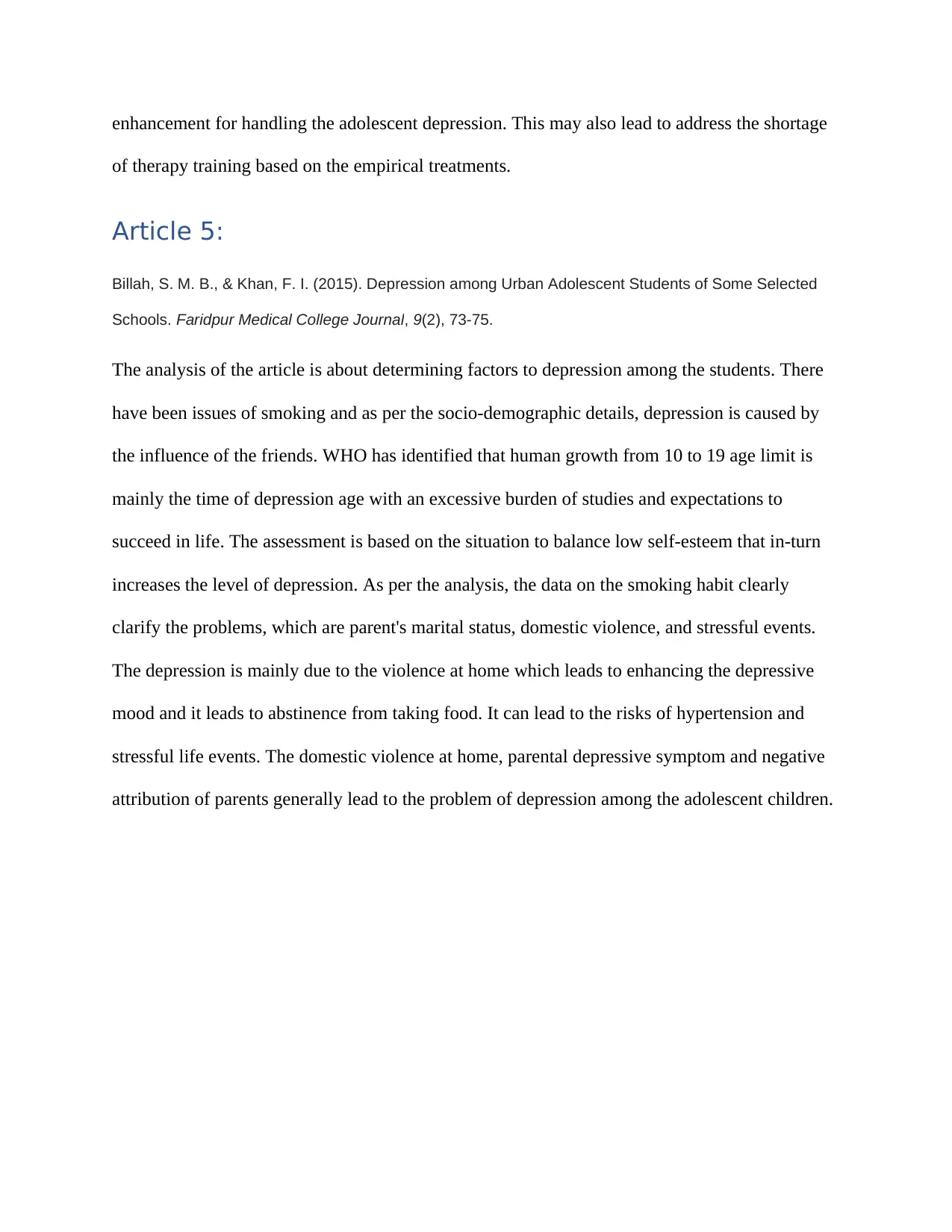
enhancement for handling the adolescent depression. This may also lead to address the shortage
of therapy training based on the empirical treatments.
Article 5:
Billah, S. M. B., & Khan, F. I. (2015). Depression among Urban Adolescent Students of Some Selected
Schools. Faridpur Medical College Journal, 9(2), 73-75.
The analysis of the article is about determining factors to depression among the students. There
have been issues of smoking and as per the socio-demographic details, depression is caused by
the influence of the friends. WHO has identified that human growth from 10 to 19 age limit is
mainly the time of depression age with an excessive burden of studies and expectations to
succeed in life. The assessment is based on the situation to balance low self-esteem that in-turn
increases the level of depression. As per the analysis, the data on the smoking habit clearly
clarify the problems, which are parent's marital status, domestic violence, and stressful events.
The depression is mainly due to the violence at home which leads to enhancing the depressive
mood and it leads to abstinence from taking food. It can lead to the risks of hypertension and
stressful life events. The domestic violence at home, parental depressive symptom and negative
attribution of parents generally lead to the problem of depression among the adolescent children.
of therapy training based on the empirical treatments.
Article 5:
Billah, S. M. B., & Khan, F. I. (2015). Depression among Urban Adolescent Students of Some Selected
Schools. Faridpur Medical College Journal, 9(2), 73-75.
The analysis of the article is about determining factors to depression among the students. There
have been issues of smoking and as per the socio-demographic details, depression is caused by
the influence of the friends. WHO has identified that human growth from 10 to 19 age limit is
mainly the time of depression age with an excessive burden of studies and expectations to
succeed in life. The assessment is based on the situation to balance low self-esteem that in-turn
increases the level of depression. As per the analysis, the data on the smoking habit clearly
clarify the problems, which are parent's marital status, domestic violence, and stressful events.
The depression is mainly due to the violence at home which leads to enhancing the depressive
mood and it leads to abstinence from taking food. It can lead to the risks of hypertension and
stressful life events. The domestic violence at home, parental depressive symptom and negative
attribution of parents generally lead to the problem of depression among the adolescent children.
You're viewing a preview
Unlock full access by subscribing today!
1 out of 6
Related Documents
Your All-in-One AI-Powered Toolkit for Academic Success.
+13062052269
info@desklib.com
Available 24*7 on WhatsApp / Email
![[object Object]](/_next/static/media/star-bottom.7253800d.svg)
Unlock your academic potential
© 2024 | Zucol Services PVT LTD | All rights reserved.



